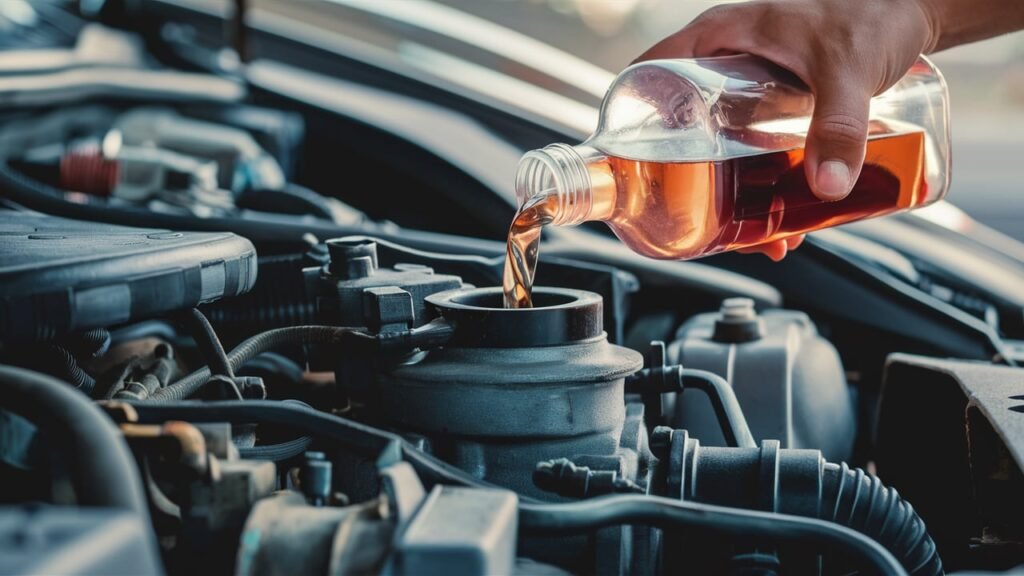
Understanding Engine Brake Fluid Capacity: A Comprehensive Guide
The brake fluid capacity for most vehicles typically ranges from 1 liter to 1.5 liters, depending on the type of brake system and the manufacturer’s recommendations. Here are some specific examples:
General Rule: Most vehicles use DOT4 brake fluid, which requires around 1 liter of brake fluid.
. Seat Cupra: The total capacity of the brake fluid tank is not explicitly mentioned, but it is recommended to use around 1 liter of brake fluid for a complete brake fluid change and bleed.
Car from Japan: For a normal car, 500 ml of brake fluid is usually enough for a flush, but if the old fluid is dirty or discolored, it may be necessary to use around 1 liter.
Jaguar: For a Jaguar, 1 liter of brake fluid is more than enough, and any spare parts shop will carry DOT4 brake fluid.
Honda Passport: The brake fluid capacity for a Honda Passport is not explicitly mentioned, but it is recommended to use around 1 liter of brake fluid for a complete brake fluid change and bleed.
It is generally recommended to consult the vehicle’s manual for specific information on brake fluid capacity and to use the correct type of brake fluid for your vehicle.
In the intricate world of automotive engineering, where precision reigns supreme, lies a critical element that often remains unsung—engine brake fluid capacity. Defined as the maximum volume of brake fluid that a vehicle’s braking system can accommodate, this seemingly unassuming specification plays a pivotal role in ensuring optimal performance and safety on the road.
Delving into the depths of engine brake fluid capacity unveils a realm where meticulous calculations meet mechanical prowess to uphold the integrity of one of an automobile’s most vital functions.

Understanding engine brake fluid capacity transcends mere numbers—it embodies an amalgamation of science and practicality essential for the maintenance and efficiency of any vehicle. As we embark on this comprehensive guide, we unravel the significance that lies within those numerical limits inscribed in technical manuals.
Peering beyond its quantitative facade, we unveil how grasping engine brake fluid capacity not only safeguards against potential malfunctions but also serves as a cornerstone for enhancing overall vehicular performance.
Join me on this educational voyage through a domain where precision converges with pragmatism, steering us towards newfound insights into the intricate mechanics underpinning every brake pedal press.
Understanding Engine Brake Fluid Capacity.
Brake fluid plays a critical role in a vehicle’s braking system, serving as the medium that transfers force from the brake pedal to the brake components. Its significance lies in its ability to withstand high temperatures generated during braking, maintaining consistent hydraulic pressure in the system.
The brake fluid’s hygroscopic nature allows it to absorb water over time, preventing moisture buildup within the braking system that could lead to corrosion and reduced performance. Understanding engine brake fluid capacity is essential for ensuring the effectiveness and safety of the braking system.
Various factors influence engine brake fluid capacity, including the type of vehicle, its size, weight distribution, and design. For example, heavy-duty trucks with air brakes will typically require larger reservoirs of brake fluid compared to compact cars due to their increased braking demands and systems’ complexities.

Moreover, vehicles equipped with performance brakes or towing capabilities may have different capacity requirements to accommodate their operational needs effectively.
To accurately check engine brake fluid capacity, refer to the vehicle manufacturer’s specifications outlined in the owner’s manual or consult service guides provided by reputable sources. Typically located near the master cylinder or within its proximity, the brake fluid reservoir indicates minimum and maximum levels that should not be exceeded or fallen below.
Utilize clean tools like a dipstick or clear tube for precise measurement without introducing contaminants into the system. Regular checks ensure that brake fluid levels remain within optimal ranges for safe and efficient braking performance.
Engine Brake Fluid Types and Capacities.
Brake fluids play a crucial role in the proper functioning of a vehicle’s braking system by transmitting force under pressure to engage the brakes. There are various types of brake fluids available in the market, with the most common being DOT 3, DOT 4, and DOT 5.
\Each type has distinct characteristics, such as boiling points and compatibility with different materials like rubber seals. The choice of brake fluid type influences the overall capacity it can hold within the braking system. For example, DOT 3 brake fluid typically has a lower boiling point compared to DOT 4 or DOT 5, affecting its capacity to withstand high temperatures without compromising performance.
The relationship between brake fluid types and their capacities stems from their chemical compositions and properties. For instance, silicone-based DOT 5 brake fluid is known for its ability to maintain a steady viscosity over a wide temperature range, which can impact how much fluid can be contained within the system while maintaining consistent performance.
When selecting a brake fluid type based on capacity requirements, factors such as operating conditions (normal daily driving versus high-performance racing), climate, and vehicle usage must be considered. High-performance vehicles may require brake fluids with higher capacities to handle increased heat generated during aggressive driving.
Factors influencing the choice of brake fluid type according to capacity requirements are crucial for optimal braking performance and safety. For example, vehicles used in extreme temperature conditions may benefit from brake fluids with higher capacities that resist boiling under heat stress.
Additionally, vehicle owners must adhere to manufacturer recommendations regarding brake fluid types and capacities specified for their particular make and model to ensure compatibility and efficient operation within the braking system.
Overall, understanding these relationships between engine brake fluid types and their respective capacities is essential for maintaining safe and effective braking systems in vehicles across different usage scenarios.
Calculating Engine Brake Fluid Capacity.
When it comes to calculating the engine brake fluid capacity for a specific vehicle, precision is key. Accurate calculations are crucial to avoid both overfilling and underfilling the braking system, as they can lead to serious safety issues and affect the performance of the vehicle.
One common method for determining the required amount of brake fluid is by consulting the vehicle’s manual. Manufacturers typically provide detailed information on the correct brake fluid capacity for each model, along with guidelines on how to measure it accurately.
In addition to referencing the vehicle manual, there are tools and formulas available that aid in determining engine brake fluid capacity effectively. For example, brake fluid calculators are handy tools that consider factors such as system volume, hydraulic pressure requirements, and potential air pockets in the system to provide precise calculations.

These calculators can be particularly useful when working on vehicles with complex braking systems or modified setups where standard guidelines may not apply directly.Importantly, accurate calculations play a significant role in preventing issues such as spongy brakes or brake failure due to insufficient or excessive brake fluid levels.
By understanding how to calculate engine brake fluid capacity correctly and utilizing appropriate tools or formulas, automotive technicians can ensure that the braking system functions optimally within its designed parameters. This meticulous approach not only enhances safety but also contributes to overall vehicle performance and longevity.
Maintaining Optimal Engine Brake Fluid Capacity.
Regular checks and maintenance are crucial in ensuring optimal brake performance by maintaining the engine brake fluid capacity within the recommended range. Insufficient brake fluid levels can lead to reduced braking power, spongy brakes, or even complete brake failure.
On the other hand, excessive brake fluid can result in issues such as difficulty in modulating brake pressure, leakage, or damage to braking components. By routinely checking and maintaining the correct fluid level, vehicle owners can ensure the safe and efficient operation of their braking systems.
Signs indicating improper engine brake fluid levels include changes in pedal feel, such as a mushy or firm pedal, squealing or grinding noises during braking, or visible signs of leaks around the wheels or under the vehicle.
Additionally, visual inspection of the brake fluid reservoir to check for the proper level and clarity of the fluid is essential in detecting any irregularities that may indicate a need for adjustment. Being proactive in monitoring these signs helps prevent potential safety hazards and costly repairs associated with brake system malfunctions due to incorrect fluid levels.

When adjusting engine brake fluid levels to maintain optimal capacity, it is essential to follow manufacturer guidelines regarding the type and quantity of brake fluid required for the specific vehicle model. The process typically involves adding small increments of brake fluid while monitoring the level closely to avoid overfilling.
Utilizing specialized tools like a turkey baster or syringe can facilitate precise adjustments without introducing air bubbles into the system. Regularly conducting these adjustments as part of routine maintenance ensures that the braking system operates at peak performance and contributes to overall vehicle safety on the road.
Engine Brake Fluid Capacity in Different Vehicle Models.
When it comes to engine brake fluid capacity, it’s essential to note the variances that exist among different vehicle makes and models. These differences are primarily influenced by factors such as the braking system design, size of the vehicle, and intended usage.
For instance, sports cars with high-performance braking systems may have larger brake fluid capacities compared to compact city cars due to their need for increased heat dissipation and braking power. Understanding these variations is crucial for mechanics and automotive technicians when servicing different vehicles.
Manufacturers play a significant role in determining the ideal brake fluid capacity for each specific vehicle model they produce. This decision involves extensive testing and engineering considerations to ensure optimal brake performance under various conditions.
For example, manufacturers like BMW or Mercedes-Benz may design their brake systems with higher capacities to accommodate heavier vehicles while maintaining safe stopping distances and durability. By adhering to these specifications set by manufacturers, technicians can help uphold the safety standards and performance capabilities of each vehicle.

Across different automotive brands, some common trends can be observed regarding engine brake fluid capacities. One prevailing trend is the increasing adoption of synthetic brake fluids in modern vehicles due to their superior performance characteristics over traditional glycol-based fluids.
Moreover, luxury car manufacturers often equip their models with larger reservoirs or integrated cooling systems for the brake fluid to enhance overall braking efficiency during demanding driving situations.
Recognizing these trends provides insights into how advancements in automotive technology continue to shape engine brake fluid capacity requirements across diverse vehicle brands.
Conclusion.
In conclusion, understanding engine brake fluid capacity is paramount for maintaining the safety and performance of a vehicle’s braking system. Brake fluid plays a critical role in ensuring that the brakes function optimally by transferring force from the brake pedal to the wheel cylinders or calipers.
By comprehending the factors influencing brake fluid capacity, such as vehicle type, size, and design, automotive professionals and enthusiasts can make informed decisions regarding the type and amount of brake fluid required.
Moreover, this comprehensive guide has shed light on the nuances of different brake fluid types, their respective capacities, as well as methods for calculating and maintaining optimal engine brake fluid levels.
Regular checks and proper maintenance are essential to prevent issues stemming from either low or excessive brake fluid levels. By following these guidelines and understanding the significance of engine brake fluid capacity across various vehicle models, individuals within the automotive industry can uphold safety standards and enhance overall driving experiences.




